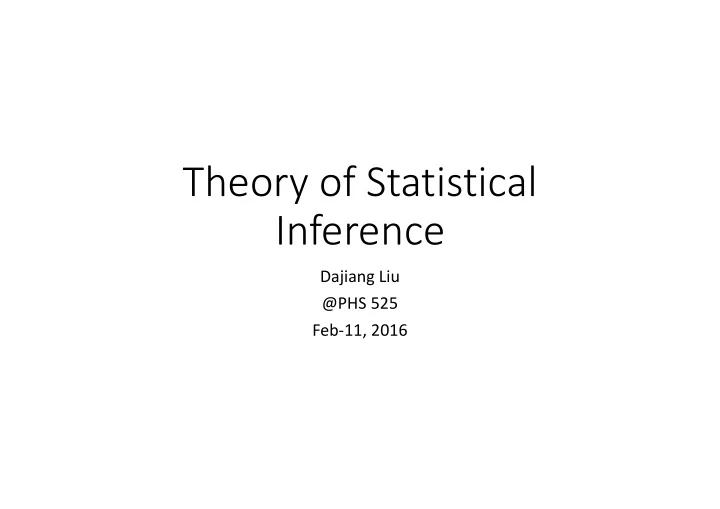

Theory of Statistical Inference Dajiang Liu @PHS 525 Feb-11, 2016
Sampling Distribution for the Mean � can be calculated • For each sample, a mean value � • What is the distribution like? • Normal distribution • For a “typical” population, the distribution for its sample mean resembles a normal distribution • Central limit theorem
Sampling Distribution for the Mean • To be more precise, � • Sample mean � • Population mean � � − � /�� � � � Follows normal distribution 95% -CI � − � −1.96 ≤ � � ≤ 1.96 �� � � ≤ � ≤ 1.96 × �� � � −1.96 × �� � � + � � + �
Confidence Interval in General • More generally, confidence interval can be expressed as ����� �������� ± � ∗ �� • Z is the Z-value, which is determined by the level of confidence interval • How to obtain z-value in R?? • qnorm(p,lower.tail=FALSE); • The parameter p should be the (1-(the size of the CI))/2 • So for 95% CI, p should be (1-95%)/2
Hypothesis Testing • Examples of hypothesis • Does the gene expression levels differ between tissues? • Do runners in 2012 of Cherry Blossom Tour run faster than in 2010 • Null hypothesis � � • A statement to be tested • Alternative hypothesis � � • An alternative statement to be examined • Alternative hypothesis can be related to many parameter values • E.g. � � : � ≠ 0 or � � : � > 0 or � � : � < 0
How does Hypothesis Testing Framework Work? • Hypothesis testing framework: • If evidence sums up against null hypothesis, we then reject the null hypothesis • If there is insufficient evidence, we fail to reject the null • In statistics, we never say “we accept the null”.
Hypothesis Testing and Confidence Intervals • If the parameter value under the null fall within the CI → fail to reject the null • If the parameter value under the null fall outside the CI → reject the null • Example: • In Run10Samp data: What is the confidence interval for the runner time? • Runner average speed in 2006: 93.29 • • In Run10, is runner running faster or not? • Must account for uncertainty in the sample • 2006 time falls in the possible range of values of running time in 2012 Fail to reject the null hypothesis •
Procedures to Perform Hypothesis Testing with CI • Step 1: Calculate mean and standard deviations of the 100 runners • Step 2: Calculate the standard error for the mean estimate • Step 3: Obtain confidence intervals for the mean • Step 4: Check if null hypothesis falls within the confidence intervals
Example 4.21 • Next consider whether there is strong evidence that the average age of runners has changed from 2006 to 2012 in the Cherry Blossom Run. In 2006, the average age was 36.13 years, and in the 2012 run10Samp data set, the average was 35.05 years with a standard deviation of 8.97 years for 100 runners. • Average age in 2006 is 36.13 years • Is the age in 2012 different from 2006?
Measure Uncertainty in Hypothesis Testing • Hypothesis testing may not be flawless • Errors can be made • Two types of errors: Type I Error and Type II Error Not Reject H 0 Reject H 0 H 0 is true Okay Type 1 Error H A is true Type II Error Okay
Type I and II Errors • Type I Error: When null hypothesis is true, but incorrectly reject the null hypothesis • Type II Error: When null hypothesis is not true, but fail to reject the null. • Example: • In a court, the defendant is either innocent ( � � ) or guilty (� � ) . • What is a type I error & type II error
Significance Level • Ideally, we want to minimize both type I and II errors • However this is not often meaningful: • Rejecting all the null hypothesis will make type II errors zero, but type I errors 1 • Strategy used: • Control for the level of type I errors (say 5%), and minimize type II errors • Significance level controls for type I errors • For example, we want to limit the type I error <5%, we use a hypothesis testing with significance level of 5%.
Measuring Significance in Hypothesis Testing: P-value • Confidence interval is a coarse/simple way of performing hypothesis testing • In practice, we want to measure how strong an evidence may be against the null hypothesis • P-value measures the probability of observing a dataset that is more favorable to the alternative hypotheses than the current observation, given that the null hypothesis is true
P-value Example – Sleep Data
- - - How to Compute P-value – Testing for Sample Mean For testing the null hypothesis that � � : � = � � • Step 1: Compute sample mean value � = � ( + � ) + ⋯ + � + � � • Step 2: Compute standard deviation for the sample � ) + ⋯ + � + − � � ) � ( − � , = � • Step 3: Compute standard error for the sample mean estimate � = ,/ � �� � • Step 4: Estimate z-score � − � /�� � � � = � • Step 5: If alternative hypothesis is � � : � > � � PVALUE = 4(5 > �) , 5 is a normal random variable • If alternative hypothesis is � � : � < � � PVALUE = 4(5 < �) • If alternative hypothesis is � � : � ≠ � � PVALUE = 2 ∗ 4 5 > �
Recommend
More recommend